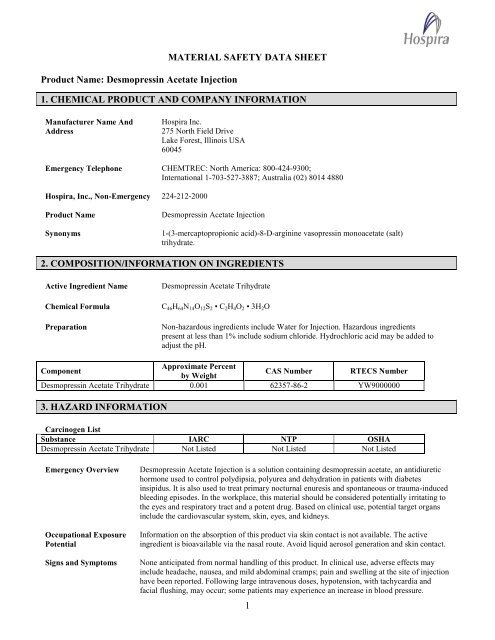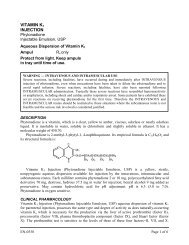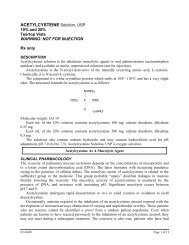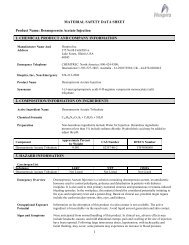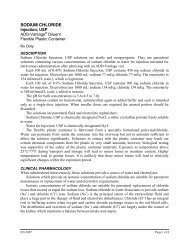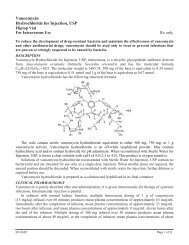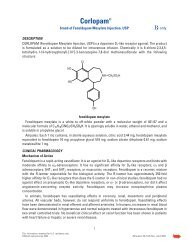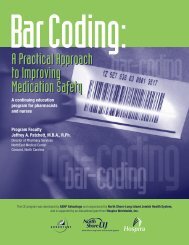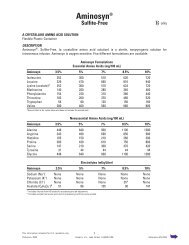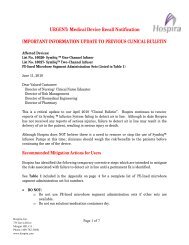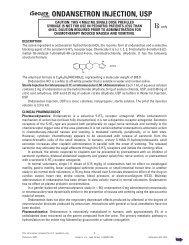Desmopressin Acetate Injection 1. CHEMICAL PRODUCT ... - Hospira
Desmopressin Acetate Injection 1. CHEMICAL PRODUCT ... - Hospira
Desmopressin Acetate Injection 1. CHEMICAL PRODUCT ... - Hospira
You also want an ePaper? Increase the reach of your titles
YUMPU automatically turns print PDFs into web optimized ePapers that Google loves.
Product Name: <strong>Desmopressin</strong> <strong>Acetate</strong> <strong>Injection</strong><br />
MATERIAL SAFETY DATA SHEET<br />
<strong>1.</strong> <strong>CHEMICAL</strong> <strong>PRODUCT</strong> AND COMPANY INFORMATION<br />
Manufacturer Name And<br />
Address<br />
<strong>Hospira</strong> Inc.<br />
275 North Field Drive<br />
Lake Forest, Illinois USA<br />
60045<br />
Emergency Telephone CHEMTREC: North America: 800-424-9300;<br />
International 1-703-527-3887; Australia (02) 8014 4880<br />
<strong>Hospira</strong>, Inc., Non-Emergency 224-212-2000<br />
Product Name<br />
<strong>Desmopressin</strong> <strong>Acetate</strong> <strong>Injection</strong><br />
Synonyms 1-(3-mercaptopropionic acid)-8-D-arginine vasopressin monoacetate (salt)<br />
trihydrate.<br />
2. COMPOSITION/INFORMATION ON INGREDIENTS<br />
Active Ingredient Name <strong>Desmopressin</strong> <strong>Acetate</strong> Trihydrate<br />
Chemical Formula C46H64N14O12S2 • C2H4O2 • 3H2O<br />
Preparation Non-hazardous ingredients include Water for <strong>Injection</strong>. Hazardous ingredients<br />
present at less than 1% include sodium chloride. Hydrochloric acid may be added to<br />
adjust the pH.<br />
Component<br />
Approximate Percent<br />
by Weight<br />
CAS Number RTECS Number<br />
<strong>Desmopressin</strong> <strong>Acetate</strong> Trihydrate 0.001 62357-86-2 YW9000000<br />
3. HAZARD INFORMATION<br />
Carcinogen List<br />
Substance IARC NTP OSHA<br />
<strong>Desmopressin</strong> <strong>Acetate</strong> Trihydrate Not Listed Not Listed Not Listed<br />
Emergency Overview <strong>Desmopressin</strong> <strong>Acetate</strong> <strong>Injection</strong> is a solution containing desmopressin acetate, an antidiuretic<br />
hormone used to control polydipsia, polyurea and dehydration in patients with diabetes<br />
insipidus. It is also used to treat primary nocturnal enuresis and spontaneous or trauma-induced<br />
bleeding episodes. In the workplace, this material should be considered potentially irritating to<br />
the eyes and respiratory tract and a potent drug. Based on clinical use, potential target organs<br />
include the cardiovascular system, skin, eyes, and kidneys.<br />
Occupational Exposure<br />
Potential<br />
Information on the absorption of this product via skin contact is not available. The active<br />
ingredient is bioavailable via the nasal route. Avoid liquid aerosol generation and skin contact.<br />
Signs and Symptoms None anticipated from normal handling of this product. In clinical use, adverse effects may<br />
include headache, nausea, and mild abdominal cramps; pain and swelling at the site of injection<br />
have been reported. Following large intravenous doses, hypotension, with tachycardia and<br />
facial flushing, may occur; some patients may experience an increase in blood pressure.<br />
1
Product Name: <strong>Desmopressin</strong> <strong>Acetate</strong> <strong>Injection</strong><br />
Medical Conditions<br />
Aggravated by Exposure<br />
4. FIRST AID MEASURES<br />
Infrequently, there may be cerebral or coronary thrombosis. Hypersensitivity reactions have<br />
also occurred. The antidiuretic action of desmopressin can produce water intoxication and<br />
hyponatraemia, occasionally leading to convulsions. Nasal doses may cause local irritation,<br />
congestion, and epistaxis. Nosebleeds have also been reported.<br />
Pre-existing hypersensitivity to desmopressin acetate or to any of the components of<br />
<strong>Desmopressin</strong> <strong>Acetate</strong> <strong>Injection</strong>; pre-existing moderate to severe renal impairment.<br />
Eye contact Remove from source of exposure. Flush with copious amounts of water. If<br />
irritation persists or signs of toxicity occur, seek medical attention. Provide<br />
symptomatic/supportive care as necessary.<br />
Skin contact Remove from source of exposure. Flush with copious amounts of water. If<br />
irritation persists or signs of toxicity occur, seek medical attention. Provide<br />
symptomatic/supportive care as necessary.<br />
Inhalation Remove from source of exposure. If signs of toxicity occur, seek medical<br />
attention. Provide symptomatic/supportive care as necessary.<br />
Ingestion Remove from source of exposure. If signs of toxicity occur, seek medical<br />
attention. Provide symptomatic/supportive care as necessary.<br />
5. FIRE FIGHTING MEASURES<br />
Flammability<br />
Fire & Explosion Hazard<br />
Extinguishing media<br />
Special Fire Fighting<br />
Procedures<br />
6. ACCIDENTAL RELEASE MEASURES<br />
None anticipated for this aqueous product.<br />
None anticipated for this aqueous product.<br />
As with any fire, use extinguishing media appropriate for primary cause of fire.<br />
No special provisions required beyond normal fire fighting equipment such as<br />
flame and chemical resistant clothing and self contained breathing apparatus.<br />
Spill Cleanup and Disposal Isolate area around spill. Put on suitable protective clothing and equipment as<br />
specified by site spill procedures. Absorb the liquid with suitable material and<br />
clean affected area with soap and water. Dispose of spill materials according to<br />
the applicable federal, state, or local regulations.<br />
7. HANDLING AND STORAGE<br />
Handling<br />
No special handling required under conditions of normal product use.<br />
Storage No special storage required for hazard control. For product protection, follow<br />
storage recommendations noted on the product case label, the primary<br />
container label, or the product insert.<br />
Special Precautions No special precautions required for hazard control.<br />
2
Product Name: <strong>Desmopressin</strong> <strong>Acetate</strong> <strong>Injection</strong><br />
8. EXPOSURE CONTROLS/PERSONAL PROTECTION<br />
Exposure Guidelines<br />
Exposure limits<br />
Component Type mg/m3 ppm µg/m3 Note<br />
<strong>Desmopressin</strong> <strong>Acetate</strong><br />
Trihydrate<br />
<strong>Hospira</strong> EEL N/A N/A 0.1 8hr TWA<br />
Respiratory<br />
protection<br />
Skin protection<br />
Eye protection<br />
Respiratory protection is normally not needed during intended product use. However, if the<br />
generation of aerosols is likely, and engineering controls are not considered adequate to<br />
control potential airborne exposures, the use of an approved air-purifying respirator with a<br />
HEPA cartridge (N95 or equivalent) is recommended under conditions where airborne<br />
aerosol concentrations are not expected to be excessive. For uncontrolled release events, or if<br />
exposure levels are not known, provide respirators that offer a high protection factor such as a<br />
powered air purifying respirator or supplied air. A respiratory protection program that meets<br />
OSHA's 29 CFR 1910.134 and ANSI Z88.2 requirements must be followed whenever<br />
workplace conditions require respirator use. Personnel who wear respirators should be fit<br />
tested and approved for respirator use as required.<br />
If skin contact with the product formulation is likely, the use of latex or nitrile gloves is<br />
recommended.<br />
Eye protection is normally not required during intended product use. However, if eye contact<br />
is likely to occur, the use of chemical safety goggles (as a minimum) is recommended.<br />
Engineering Controls Engineering controls are normally not needed during the normal use of this product.<br />
9. PHYSICAL/<strong>CHEMICAL</strong> PROPERTIES<br />
Appearance/Physical State Liquid<br />
Color Clear<br />
Odor NA<br />
Odor Threshold: NA<br />
pH: 3.5 to 6.0<br />
Melting point/Freezing point: NA<br />
Initial Boiling Point/Boiling Point NA<br />
Range:<br />
Evaporation Rate: NA<br />
Flammability (solid, gas): NA<br />
Upper/Lower Flammability or NA<br />
Explosive Limits:<br />
Vapor Pressure: NA<br />
Vapor Density: NA<br />
Specific Gravity: NA<br />
Solubility: NA<br />
Partition coefficient: n-octanol/water: NA<br />
Auto-ignition temperature: NA<br />
Decomposition temperature: NA<br />
3
Product Name: <strong>Desmopressin</strong> <strong>Acetate</strong> <strong>Injection</strong><br />
10. STABILITY AND REACTIVITY<br />
Reactivity<br />
Chemical Stability<br />
Hazardous Reactions<br />
Conditions to avoid<br />
Incompatibilities<br />
Hazardous decomposition<br />
products<br />
Not determined.<br />
Stable under standard use and storage conditions.<br />
Not determined.<br />
Not determined.<br />
Not determined.<br />
Not determined. During thermal decomposition, it may be possible to generate<br />
irritating vapors and/or toxic fumes of carbon oxides (COx), nitrogen oxides<br />
(NOx), and sulfur oxides (SOx).<br />
Hazardous Polymerization Not anticipated to occur with this product.<br />
1<strong>1.</strong> TOXICOLOGICAL INFORMATION<br />
Acute Toxicity<br />
Not determined for the product formulation. Information for the ingredients is as follows:<br />
Ingredient(s) Percent Test Type<br />
<strong>Desmopressin</strong> <strong>Acetate</strong> Trihydrate 100 LD50<br />
Aspiration Hazard<br />
Dermal Irritation/Corrosion<br />
Ocular Irritation/Corrosion<br />
Dermal or Respiratory<br />
Sensitization<br />
Reproductive Effects<br />
Mutagenicity<br />
Carcinogenicity<br />
Target Organ Effects<br />
4<br />
Route of<br />
Administration<br />
Intravenous<br />
Intravenous<br />
None anticipated from normal handling of this product.<br />
None anticipated from normal handling of this product.<br />
Value Units Species<br />
>2<br />
>50<br />
mg/kg<br />
mcg/kg<br />
None anticipated from normal handling of this product. However, inadvertent<br />
contact of this product with eyes may produce irritation.<br />
None anticipated from normal handling of this product.<br />
Fertility studies have not been conducted. However, teratology studies in rats<br />
and rabbits at dosages from 0.05 to 10 mcg/kg/day (approximately 0.1 times<br />
the maximum systemic human exposure in rats and up to 38 times the<br />
maximum systemic human exposure in rabbits based on surface area, mg/m2)<br />
revealed no harm to the fetus due to desmopressin acetate.<br />
Studies with desmopressin acetate have not been performed to evaluate the<br />
mutagenic potential.<br />
Studies with desmopressin acetate have not been performed to evaluate the<br />
carcinogenic potential.<br />
Based on clinical use, potential target organs include the cardiovascular<br />
system, skin, eyes, and kidneys.<br />
Rat, Mouse<br />
Rabbit
Product Name: <strong>Desmopressin</strong> <strong>Acetate</strong> <strong>Injection</strong><br />
12. ECOLOGICAL INFORMATION<br />
Aquatic Toxicity<br />
Persistence/Biodegradability<br />
Bioaccumulation<br />
Mobility in Soil<br />
13. DISPOSAL CONSIDERATIONS<br />
Waste Disposal<br />
Container Handling and<br />
Disposal<br />
Not determined for product<br />
Not determined for product.<br />
Not determined for product.<br />
Not determined for product.<br />
14. TRANSPORTATION INFORMATION<br />
ADR/ADG/ DOT STATUS: Not regulated<br />
IMDG STATUS: Not regulated<br />
ICAO/IATA STATUS: Not regulated<br />
Transport Comments: None<br />
15. REGULATORY INFORMATION<br />
All waste materials must be properly characterized. Further, disposal should be<br />
performed in accordance with the federal, state or local regulatory<br />
requirements.<br />
Dispose of container and unused contents in accordance with federal, state and<br />
local regulations.<br />
USA Regulations<br />
Substance TSCA Status<br />
<strong>Desmopressin</strong> <strong>Acetate</strong> Trihydrate Not Listed<br />
CERCLA<br />
Status<br />
Not Listed<br />
SARA 302<br />
Status<br />
Not Listed<br />
SARA 313<br />
Status<br />
Not Listed<br />
PROP 65<br />
Status<br />
Not Listed<br />
RCRA Status Not Listed<br />
U.S. OSHA<br />
Classification<br />
GHS<br />
Classification<br />
Target Organ Toxin<br />
Possible Irritant<br />
Hazard Class Not Applicable<br />
Hazard<br />
Category<br />
*In the EU, classification under GHS/CLP does not apply to certain substances and mixtures, such as<br />
medicinal products as defined in Directive 2001/83/EC, which are in the finished state, intended for the<br />
final user:<br />
Not Applicable<br />
Signal Word Not Applicable<br />
5
Product Name: <strong>Desmopressin</strong> <strong>Acetate</strong> <strong>Injection</strong><br />
Symbol Not Applicable<br />
Prevention P260 - Do not breathe dust/fume/gas/mist/vapors’/spray.<br />
Hazard<br />
Statement<br />
Not Applicable<br />
Response: IF IN EYES: Rinse cautiously with water for several minutes. Remove contact lenses, if present and easy<br />
to do. Continue rinsing. If eye irritation persists, get medical attention. Wash hands after handling.<br />
Get medical attention if you feel unwell.<br />
EU Classification*<br />
*Medicinal products are exempt from the requirements of the EU Dangerous Preparations Directive. Information provided below is<br />
for the pure drug substance <strong>Desmopressin</strong> <strong>Acetate</strong> Trihydrate<br />
.<br />
Classification(s): Not Applicable<br />
Symbol: Not Applicable<br />
Indication of Danger: Not Applicable<br />
Risk Phrases: R00 - Not Applicable<br />
Safety Phrases: S23 - Do not breathe vapour.<br />
S24/25 - Avoid contact with skin and eyes.<br />
S37/39 - Wear suitable gloves and eye/face protection.<br />
16. OTHER INFORMATION:<br />
Notes:<br />
ACGIH TLV American Conference of Governmental Industrial Hygienists – Threshold Limit Value<br />
CAS Chemical Abstracts Service Number<br />
CERCLA US EPA law, Comprehensive Environmental Response, Compensation, and Liability Act<br />
DOT US Department of Transportation Regulations<br />
EEL Employee Exposure Limit<br />
IATA International Air Transport Association<br />
LD50 Dosage producing 50% mortality<br />
NA Not applicable/Not available<br />
NE Not established<br />
NIOSH National Institute for Occupational Safety and Health<br />
OSHA PEL US Occupational Safety and Health Administration – Permissible Exposure Limit<br />
Prop 65 California Proposition 65<br />
RCRA US EPA, Resource Conservation and Recovery Act<br />
RTECS Registry of Toxic Effects of Chemical Substances<br />
SARA Superfund Amendments and Reauthorization Act<br />
STEL 15-minute Short Term Exposure Limit<br />
TSCA Toxic Substance Control Act<br />
TWA 8-hour Time Weighted Average<br />
MSDS Coordinator: <strong>Hospira</strong> GEHS<br />
Date Prepared: 09/13/2011<br />
Obsolete Date: 11/17/2010<br />
6
Product Name: <strong>Desmopressin</strong> <strong>Acetate</strong> <strong>Injection</strong><br />
Disclaimer:<br />
The information and recommendations contained herein are based upon tests believed to be reliable. However,<br />
<strong>Hospira</strong> does not guarantee their accuracy or completeness NOR SHALL ANY OF THIS INFORMATION<br />
CONSTITUTE A WARRANTY, WHETHER EXPRESSED OR IMPLIED, AS TO THE SAFETY OF THE<br />
GOODS, THE MERCHANTABILITY OF THE GOODS, OR THE FITNESS OF THE GOODS FOR A<br />
PARTICULAR PURPOSE. Adjustment to conform to actual conditions of usage may be required. <strong>Hospira</strong><br />
assumes no responsibility for results obtained or for incidental or consequential damages, including lost profits,<br />
arising from the use of these data. No warranty against infringement of any patent, copyright or trademark is made<br />
or implied.<br />
7


